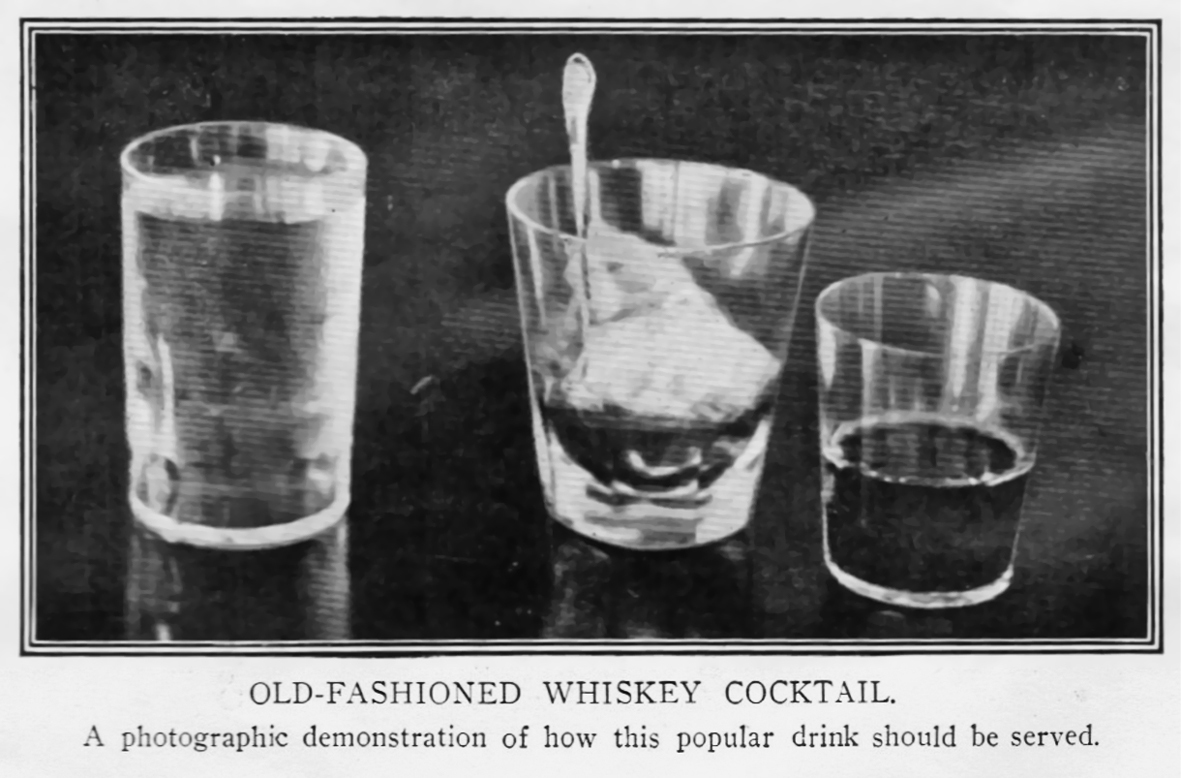The Old-Fashioned Cocktail , properly made, with sugar, bitters, ice, and (generally) American whisky, is an example of what the “original” cocktail would have been like: the first known definition of a cocktail (which dates back to 1806) described its ingredients as “spirits of any kind, sugar, water, and bitters.” Freeze the water, and there’s not a whisker of difference between them. See Cock-Tail. For many years, cocktails remained only slightly more complicated than this mixture, a simple one indeed. They came with utilitarian names such as “Gin Cocktail,” “Whisky Cocktail,” “Brandy Cocktail,” and sometimes, stretching the boundaries, “Fancy Gin Cocktail,” which might differ only in the use of a “fancy” stemmed glass and the addition of a lemon twist.
In the 1850s and 1860s, the cocktail started to evolve as bartenders began experimenting with adding splashes of standard liqueurs to the formula—curaçao, maraschino, and the like. But it was only in the 1870s that this evolution yielded something that stepped outside the original definitions, when bartenders began lightening the drink by replacing half the base liquor with vermouth (then new to most Americans). While this yielded such classics as the Manhattan and the Martini, some drinkers preferred their cocktails made using the tried-and-true formula and consequently would call for an “old-fashioned” cocktail. Based on the recipe books of the day, the most popular of these was the Old-Fashioned Whisky Cocktail, which was soon shortened to just “Old-Fashioned.” Other versions were in circulation, however, the most popular of them being the Old-Fashioned Gin Cocktail, with genever or a domestic equivalent, and the Old-Fashioned Brandy Cocktail. This last was particularly popular in Wisconsin, and to this day if anyone orders an Old-Fashioned in the state, it will most likely be made with brandy instead of whisky.
While many accounts put the birthplace of the Old-Fashioned as the Pendennis Club in Louisville, Kentucky, people were ordering Old-Fashioneds in Chicago a year before the Pendennis Club was founded (in 1881) and a full three years before it even had a bar. The Pendennis Club may have popularized the drink, but that would be the most that it could or should claim.
During Prohibition and the World War II years, the Old-Fashioned ran into hard times. While the recipes for many standards, such as the Martini, the Manhattan, and the Daiquiri, managed to escape without much doctoring, the Old-Fashioned was not so fortunate. By the late 1940s, it was all too often turned into an overdiluted mess, topped with more water or club soda then there was spirit in the drink. Worse, it was often oversweetened and made further flaccid with the addition of a muddled orange wheel and the smashed remains of a processed maraschino cherry. (Some say this practice started during Prohibition to mask the taste of bad booze.) These changes to the recipe may account for the severe drop-off in the drink’s popularity during the latter half of the twentieth century.
The resurgence of classic cocktails, which began in the late 1990s, would bring a new focus on restoring drink recipes back to their original glory. Thankfully, the classic Old-Fashioned recipe was found and dusted off. Now, a new generation of bartenders was making Old-Fashioneds that their great-grandfathers would have been able to recognize and thoroughly enjoy. But these, it turns out, also appealed mightily to the new bartenders’ contemporaries: the new Old-Fashioned is one of the great success stories of the cocktail renaissance and is perennially cited as one of the most popular drinks served in cocktail bars.
See also Manhattan Cocktail; Martinez; and Martini.
Recipe: In a heavy-bottomed glass, muddle 1 sugar cube (or 5 ml sugar), 5 ml water and 2–3 dashes Angostura or other bitters. Fill glass with ice, add 60 ml straight rye or bourbon whisky, stir well, and twist lemon peel (for rye) or orange peel (for bourbon) over the top.
Wondrich, David. Imbibe!, 2nd ed. New York: Perigee, 2015.
By: Robert Hess and David Wondrich
The fancy way to serve an Old-Fashioned, as photographed at the Hoffman House bar, 1905. The patron would pour his own whisky and pour it into the glass with the ice and pre-mixed bitters and sugar. Note the ice water on the side.
Wondrich Collection.
 The fancy way to serve an Old-Fashioned, as photographed at the Hoffman House bar, 1905. The patron would pour his own whisky and pour it into the glass with the ice and pre-mixed bitters and sugar. Note the ice water on the side. Source: Wondrich Collection.
The fancy way to serve an Old-Fashioned, as photographed at the Hoffman House bar, 1905. The patron would pour his own whisky and pour it into the glass with the ice and pre-mixed bitters and sugar. Note the ice water on the side. Source: Wondrich Collection.
